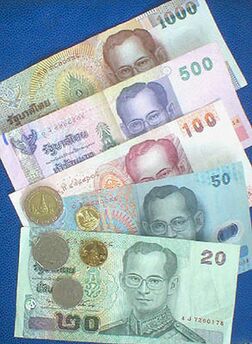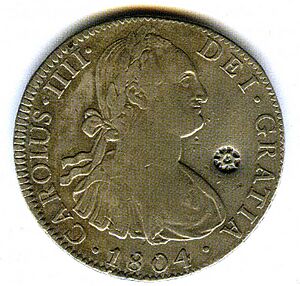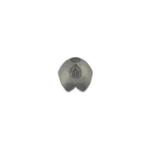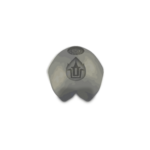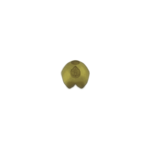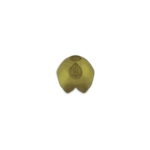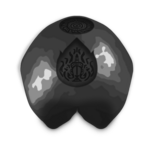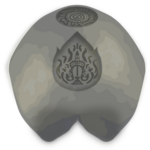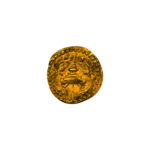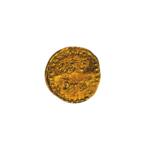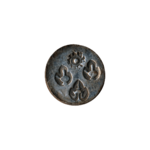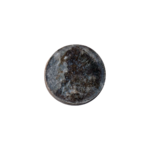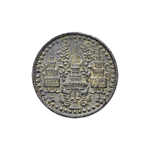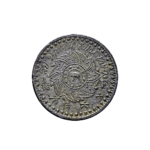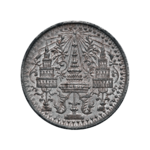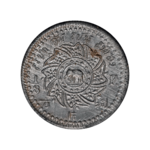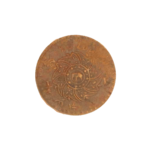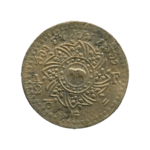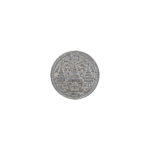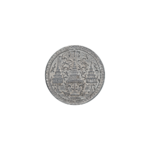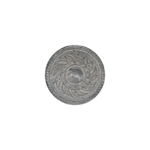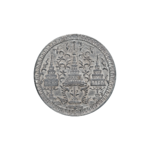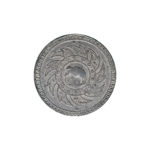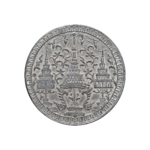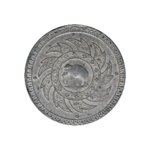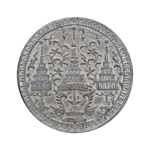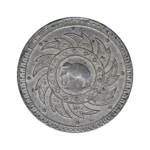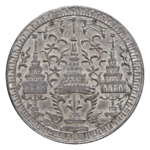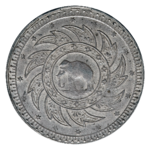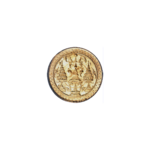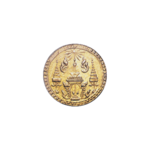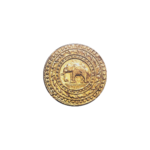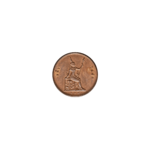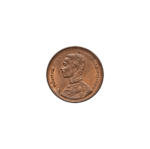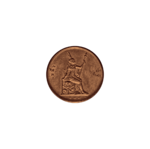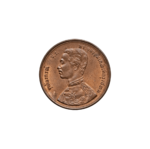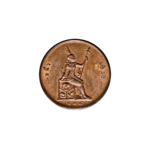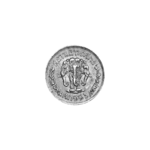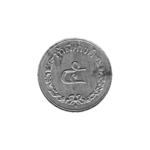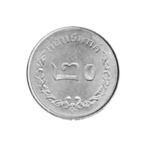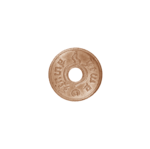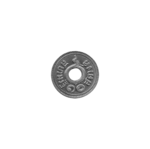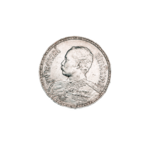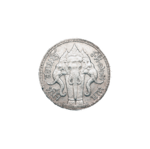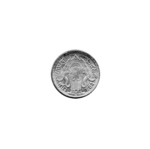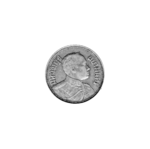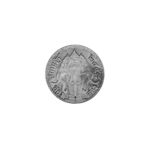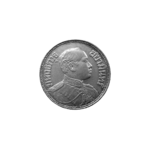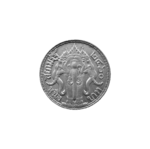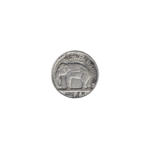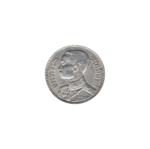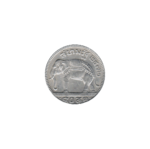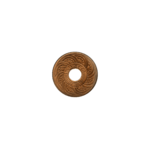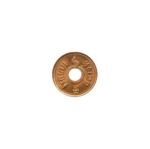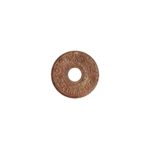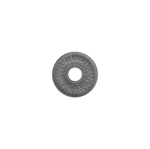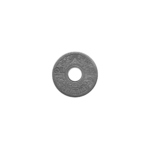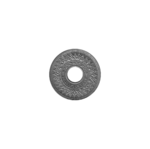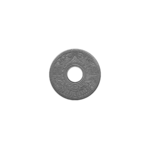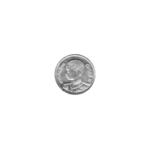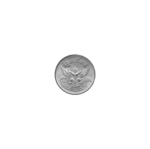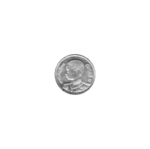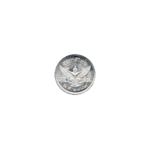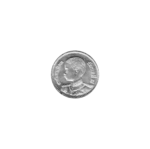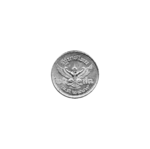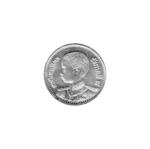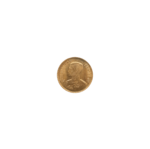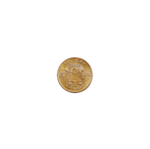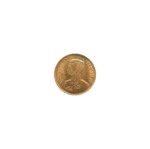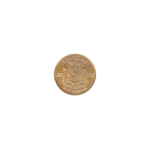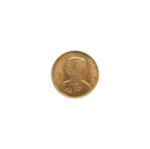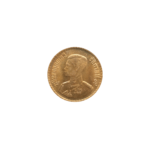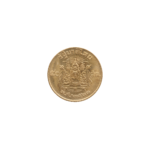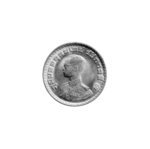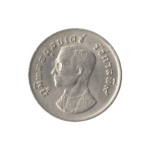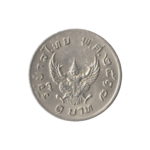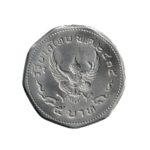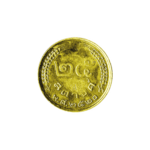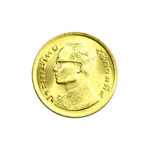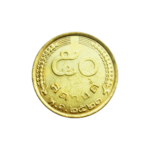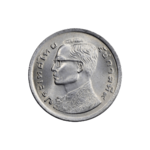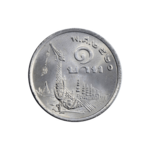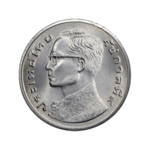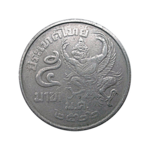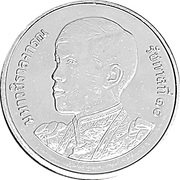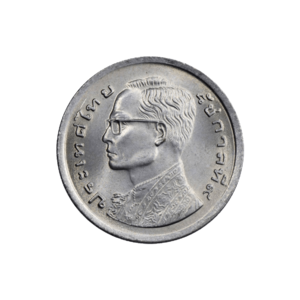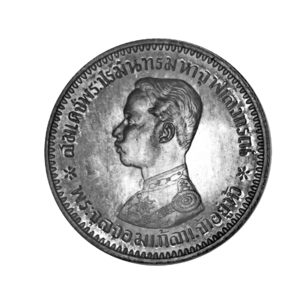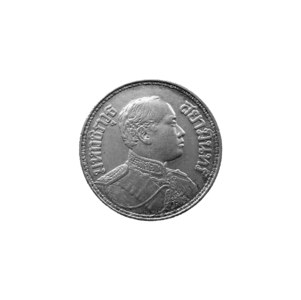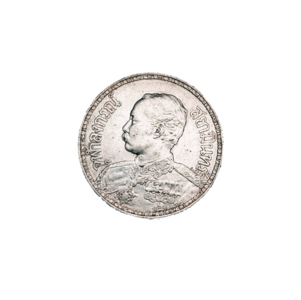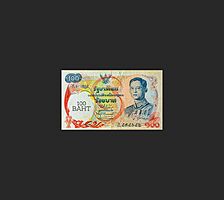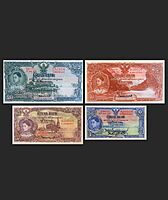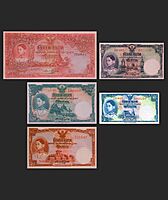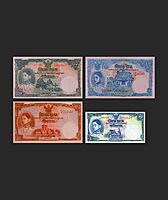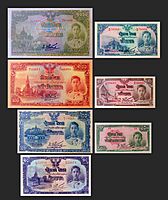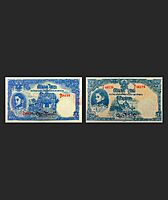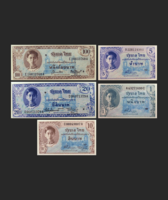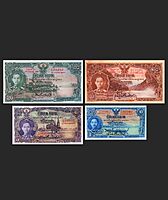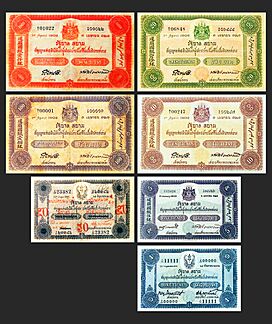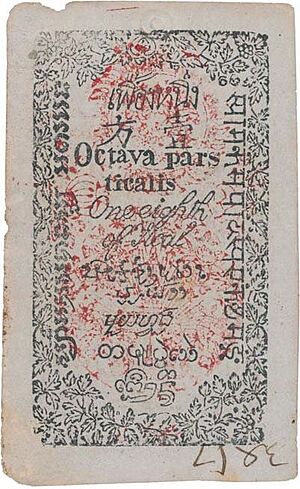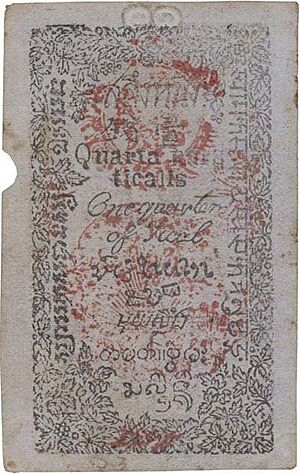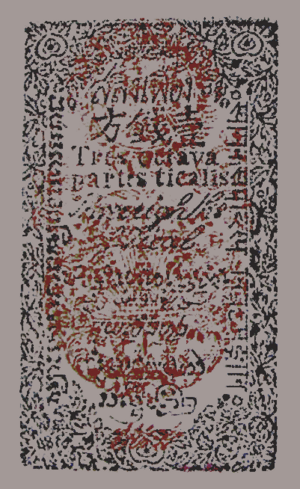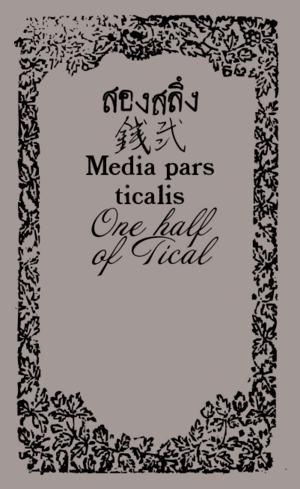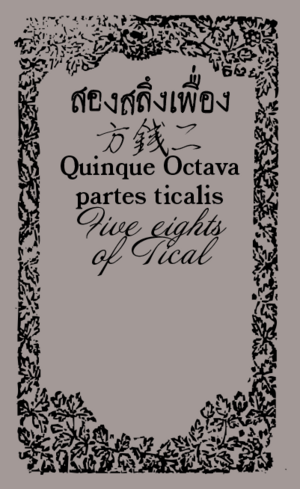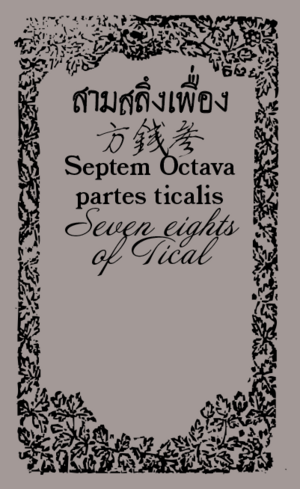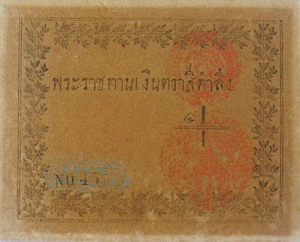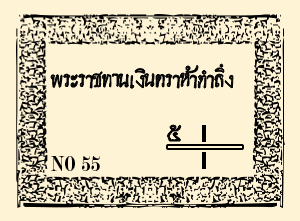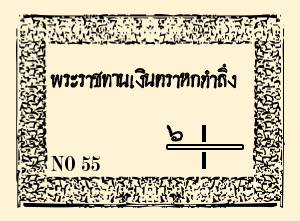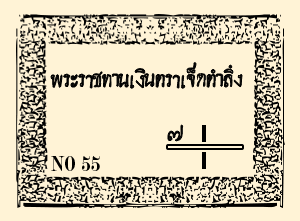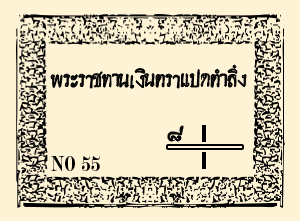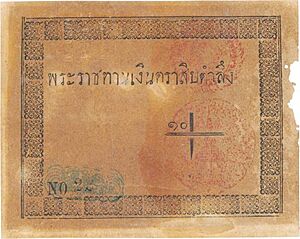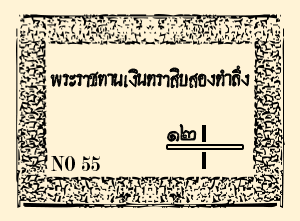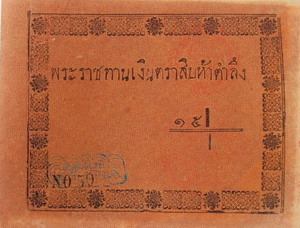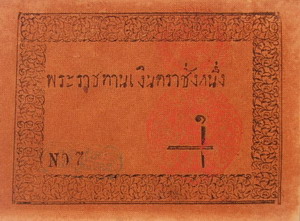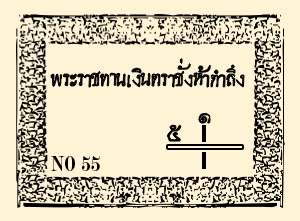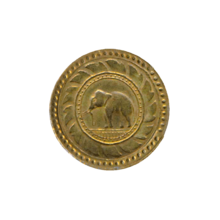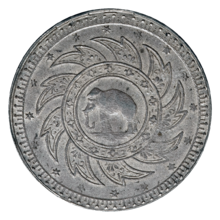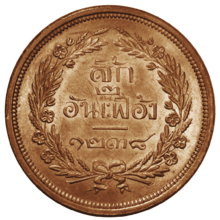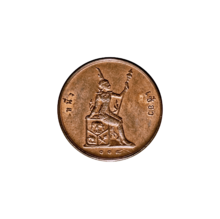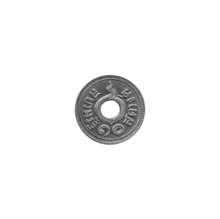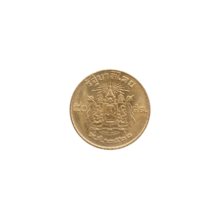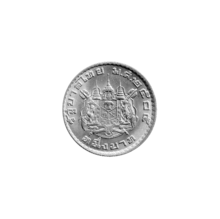Thai baht facts for kids
Quick facts for kids Thai baht |
|||
|---|---|---|---|
|
|||
| ISO 4217 Code | THB | ||
| Official user(s) | |||
| Unofficial user(s) | |||
| Inflation | 1.0% | ||
| Source | Inflation (annual %), World Bank, 2011–2015 | ||
| Subunit | |||
| 1⁄100 | satang | ||
| Symbol | ฿ | ||
| Plural | The language(s) of this currency does not have a morphological plural distinction. | ||
| Coins | |||
| Freq. used | 25, 50 satang, ฿1, ฿2, ฿5, ฿10 | ||
| Rarely used | 1, 5, 10 satang | ||
| Banknotes | |||
| Freq. used | ฿20, ฿50, ฿100, ฿500, ฿1000 | ||
| Printer | Note Printing Works of the Bank of Thailand | ||
The baht (/bɑːt/; Thai: บาท, pronounced [bàːt]; sign: ฿; code: THB) is the official currency of Thailand. It is divided into 100 satang (สตางค์, pronounced [sà.tāːŋ]). Prior to decimalisation, the baht was divided into eight feuang (เฟื้อง, pronounced [fɯá̯ŋ]), each of eight att (อัฐ, pronounced [ʔat̚]). The issuance of currency is the responsibility of the Bank of Thailand. SWIFT ranked the Thai baht as the 10th-most-frequently used world payment currency as of December 2023.
Contents
- History
- Currency symbol
- Coins
- Banknotes
- Timeline
- 2003-present (Series 14 to Series 17) Later Rama 9 and Rama 10 Era
- 1948-2003 (Series 9 to Series 13) Early Rama 9 Era
- 1935-1948 (Series 3 Type II to Series 8) Rama 8 Era
- 1925-1935 (Series 2 to Series 3 Type I) Rama 7 Era
- 1902-1925 (Series 1) Rama 5 and Rama 6 Era
- Before 1902 Pre Decimalization Era
- Money and unit of mass
- Exchange rates
- See also
History
The Thai baht, like the pound, originated from a traditional unit of mass. Its currency value was originally expressed as that of silver of corresponding weight (now defined as 15 grams), and was in use probably as early as the Sukhothai period in the form of bullet coins known in Thai as photduang. These were pieces of solid silver cast to various weights corresponding to a traditional system of units related by simple fractions and multiples, one of which is the baht. These are listed in the following table: Though the coins themselves have names like: solot, siao, phai, etc, the formal division of the Thai Baht/Tical is 1 baht = 8 feuang = 64 att. This means that one baht is divided into eight feuang, and each one feuang is divided into 8 att. Currently, the Thai baht do not employ the att as a subunit, but the att is the current subunit of the Laos Kip.
| Unit (RTGS) | Thai spelling | Relative value | Value relative to | Notes | |
|---|---|---|---|---|---|
| Baht | Satang | ||||
| Bia | เบี้ย | 1⁄100 at | 1⁄6400 | 0.0156 | Bia is Thai for cowry, the shell of which was used as a trade medium of the same value. |
| Solot | โสฬส | 1⁄16 fueang | 1⁄128 | 0.78 | Solot here literally means sixteen or sixteenth, referring to the fractional amount relative to a fueang. |
| Att | อัฐ | 1⁄8 fueang | 1⁄64 | 1.56 | Likewise, at literally means eight. |
| Siao/Phai | เสี้ยว/ไพ | 1⁄4 fueang | 1⁄32 | 3.125 | Siao means quarter. |
| Sik | ซีก | 1⁄2 fueang | 1⁄16 | 6.25 | Sik means half. |
| Fueang | เฟื้อง | 1⁄8 baht | 1⁄8 | 12.5 | The smallest silver bullet coins available in the market. |
| Salueng | สลึง | 1⁄4 baht (0.25 baht, 25 satang) | 1⁄4 | 25 | Thai version of the mace. It is also the equivalent of the Cambodian salong, and Burmese pya. |
| Song salueng | สองสลึง | 1⁄2 baht (0.50 baht, 50 satang) | 1⁄2 | 50 | |
| Baht | บาท | 1 | 100 | It is also the equivalent of the Cambodian baat, and Burmese kyat. Its alternative name is the tical. | |
| Tamlueng | ตำลึง | 4 baht | 4 | 400 | Thai version of the tael. |
| Chang | ชั่ง | 20 tamlueng | 80 | 8000 | Thai version of the catty. |
| Hab | หาบ | 80 chang | 6400 | 640000 | |
That system was in use up until 1897, when the decimal system devised by Prince Jayanta Mongkol, in which one baht = 100 satang, was introduced by his half-brother King Chulalongkorn along with the demonetization of silver bullet coins on 28 October 1904 after the end of silver bullet coin production by the opening of Sitthikarn Royal Mint in 1857. However, coins denominated in the old units were issued until 1910, and the amount of 25 satang is still commonly referred to as a salueng, as is the 25-satang coin.
Until 27 November 1902, the baht was fixed on a purely silver basis, with 15 grams of silver to the baht. This caused the value of the currency to vary relative to currencies on a gold standard. From 1856 to 1864, the values of certain foreign silver coins were fixed by law, with 5 baht = 3 Spanish dollar = 7 Indian rupees. Before 1880 the exchange rate was fixed at 8 baht per pound sterling, falling to 10 to the pound during the 1880s.
In 1902, the government began to increase the value of the baht by following all increases in the value of silver against gold but not reducing it when the silver price fell. Beginning at 21.75 baht per pound sterling, the currency rose in value until, in 1908, a fixed peg to the British pound sterling was established of 13 baht per pound. This was revised to 12 baht in 1919 and then, after a period of instability, to 11 baht in 1923. During World War II, the baht was fixed at a value of one Japanese yen on 22 April 1942.
From 1956 until 1973, the baht was pegged to the US dollar at an exchange rate of 20.8 baht = one dollar and at 20 baht = 1 dollar until 1978. A strengthening US economy caused Thailand to re-peg its currency at 25 to the dollar from 1984 until 2 July 1997, when the country was affected by the 1997 Asian financial crisis. The baht was floated and halved in value, reaching its lowest rate of 56 to the dollar in January 1998. It rose to 30 per dollar in January 2021.
The baht was originally known to foreigners by the term tical, which was used in English language text on banknotes until the series 2 1925.
Currency symbol
The currency symbol for the baht is ฿ (a latin letter B with a vertical stroke). In 1986, this symbol was given a codepoint for computer use in the Thai Industrial Standard 620-2533 (Thailand's extension of ASCII), at position 0xDF. This national standard was subsequently subsumed into international standards as ISO/IEC 8859-11 ("ISO Latin-Thai"). In turn, the ISO 8859 series were transposed into the Unicode standard, where the symbol was allocated the codepoint Error using : Input "0E3F" is not a hexadecimal value.. The symbol is also used for the Panamanian balboa.
Abbreviation
In Thai usage, the baht (บาท) is legally abbreviated as บ. according to Section 7 of the Currency Act, B.E. 2501.
Bitcoin
For a time, the baht symbol was appropriated by some as a symbol for Bitcoin, a cryptocurrency. Following representations, a separate code point (Error using : Input "20BF" is not a hexadecimal value., a latin letter B with two vertical strokes) was allocated in Unicode version 10.0.
Square katakana
In Unicode 1.0, two codepoints were allocated to the baht, one as the currency symbol in the Thai range and one in the CJK Compatibility block as a square version of the Japanese word for "baht", written in katakana script. The CJK codepoint, Error using : Input "332C" is not a hexadecimal value., is documented in subsequent versions of the standard as "a mistaken, unused representation" and users are directed to Error using : Input "0E3F" is not a hexadecimal value. instead. Consequently, only a few computer fonts have any content for this codepoint and its use is deprecated.
(The Japanese for "baht" is バーツ (bātsu). However, the reference glyph ⟨㌬⟩ and the character name correspond to パーツ (pātsu, from English "parts").)
Coins
Photduang coinage
Cowrie shells from the Mekong River had been used as currency for small amounts since the Sukhothai period. Before 1860, Thailand did not produce coins using modern methods. Instead, a so-called "bullet" coinage was used, consisting of bars of metal, thicker in the middle, bent round to form a complete circle on which identifying marks were stamped. Denominations issued included 1⁄128, 1⁄64, 1⁄32, 1⁄16, 1⁄8, 1⁄2, 1, 1+1⁄2, 2, 2+1⁄2, 4, 4+1⁄2, 8, 10, 20, 40 and 80 baht in silver and 1⁄32, 1⁄16, 1⁄8, 1⁄2, 1, 1+1⁄2, 2 and 4 baht in gold. One gold baht was generally worth 16 silver baht. Between 1858 and 1860, foreign trade coins were also stamped by the government for use in Thailand.
Pod Duang During the Sukhothai Period and Ayutthaya Period
Pod Duang, a form of currency used during the Sukhothai period, was characterized by its longer legs, which created a larger and wider hole in the middle. These coins were primarily made of silver and featured a cut across the front of each leg. This cut served a dual purpose: it authenticated the money and allowed for the quality of the silver to be tested. Over time, as the Sukhothai Kingdom declined and became a vassal state of Ayutthaya—which was established as the capital in 1350 A.D.—the design of Pod Duang evolved. The coins became rounder with shorter legs, and the central hole, while still present, grew smaller. By the end of this era, the hole disappeared completely. The cuts on the legs also reduced in size and were eventually replaced by a small elliptical nick, known as "Met Kao San," on one side of the coin.
Pod Duang in the Thonburi and Rattanakosin Periods
The Thonburi period (1767-1782 A.D.) and the Rattanakosin period, beginning in 1782 A.D., adopted the Pod Duang design from the late Ayutthaya period. The coins from these periods had no central hole, and the legs were even shorter. A key difference was that Thonburi Pod Duang lacked the elliptical nick, whereas the Rattanakosin coins reintroduced this feature, similar to the Ayutthaya coins. Pod Duang from these later periods typically featured two stamped marks: the Dynasty mark on top and the king's personal mark on the front part. The Dynasty mark often symbolized the kingdom's ruling dynasty, while the king's personal mark represented the reigning monarch.
Markings and Production of Pod Duang
The markings on Pod Duang coins varied across different periods. During the Sukhothai era, some coins bore no marks, while others had up to 11. This variation was because, at that time, individuals and merchants could produce their own money. However, from the Ayutthaya period onward, the production of Pod Duang was monopolized by the government, making it easier to identify coins from each era. Ayutthaya Pod Duang typically bore two marks: the Dynasty mark, which could be a spoked wheel symbolizing the "Wheel of Law" from Buddhist teachings or the Chakra (Vishnu's weapon), represented by a pattern of 8 dots surrounding a central dot. The king's personal mark varied with each ruler and included symbols such as a conch shell, a Garuda bird (Krut), an elephant, and an anchor, each symbolizing different aspects of the king's reign or divine associations.
Podduang Timeline
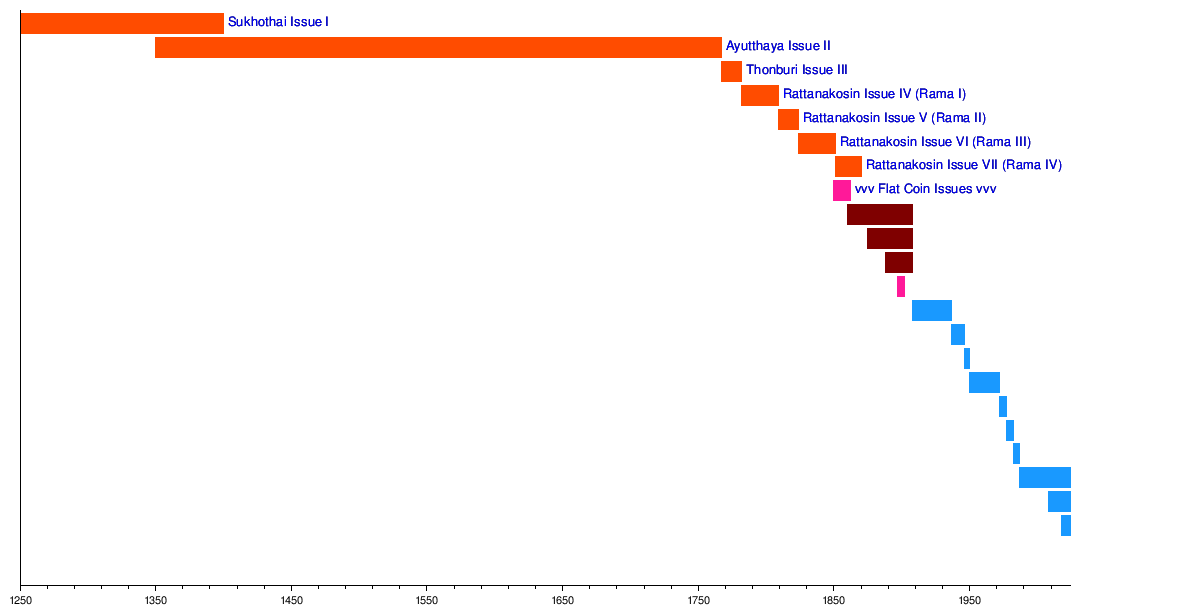
*continues in the coin section*
Predecimal coinage
Rama III (1824–1851) was the first king to consider the use of a flat coin. He did so not for the convenience of traders, but because he was disturbed that the creatures living in the cowrie shells were killed. When he learned of the use of flat copper coins in Singapore in 1835, he contacted a Scottish trader, who had two types of experimental coins struck in England. The king rejected both designs. The name of the country put on these first coins was Muang Thai, not Siam.
In 1860, modern style coins were introduced. These were silver 1 sik, 1 fuang, 1 and 2 salung, 1, 2 and 4 baht, with the baht weighing 15.244 grams and the others weight-related. Tin 1 solot and 1 att followed in 1862, with gold 2+1⁄2, 4 and 8 baht introduced in 1863 and copper 2 and 4 att in 1865. Copper replaced tin in the 1 solot and 1 att in 1874, with copper 4 att introduced in 1876. The last gold coins were struck in 1895.
Coin Timeline

Issue 1 - 1856
The first issue of coins were commissioned by Rama IV, though it was never brought into circulation. This was one of the first attempt to replace the bullet coins, but few were ever minted without making it into circulation.
Issue 2 - 1860
The first circulating issue of the Siamese coins. This marks the start of the move away from using photduang currency. Though in this era, the photduang are still legal tender. In this series, the lower denominations are made of silver, and the higher ones are made of gold. These higher denominations are given nicknames: Paddueng, Pit, and Tot. Paddueng means thirty two, as in 1/32 of a chang, the other nick name is the chinkang or one chinese tamlueng. The pit means twenty, as in 1/20 of a chang, the other name is ekkang, or one thai tamleung. The tot means ten, as in 1/10 of a chang, the coin is also called thukkang, which means two tamlueng. In the lower denominations materials such as tin, copper and brass are used, since these are quite low value.
Issue 3 - 1875
The first series to depict king Rama V, this issue coins are made of copper, silver, and gold. Though, gold is strangely only used in the 1 feuang denomination. The new shield emblem is introduced in this issue. This shield is separated into three section, drawing from western influences, symbols within these sections represents territories Siam is controlling. The tree headed elephant represents Siamese territory, the bottom-left elephant represent Lan Xang, and the warangka represents Siamese Malaya.
| Rama V, Issue 3 | |||||||||
|---|---|---|---|---|---|---|---|---|---|
| Image | Value | Dimensions (mm) |
Weight (g) |
Composition | Inscription, Description | Date of Issue | |||
| Obverse | Reverse | Name | Coinage Value | Obverse | Reverse | ||||
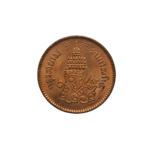 |
 |
Solot โสฬส |
1/16 Feuang, 1/128 Baht |
20 × 1 | 2.67 | Copper | กรุงสยาม (Kingdom of Siam) The Monogram of Rama V รัชกาลที่ ๕ (5th Reign) |
โสลด (Solot) ๑๖ (16) อันเฟื้อง (parts fuang) ๑๒๓๖ (CS 1236) |
1875 |
 |
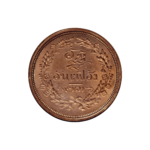 |
Att อัฐ |
1/8 Feuang, 1/64 Baht |
25 × 1 | 5.58 | Copper | กรุงสยาม (Kingdom of Siam) The Monogram of Rama V รัชกาลที่ ๕ (5th Reign) |
อัฐ (Att) ๘ (8) อันเฟื้อง (parts fuang) ๑๒๓๖ (CS 1236) |
1875 |
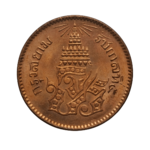 |
 |
Siao เสี้ยว |
1/4 Feuang, 1/32 Baht |
30.5 × 2 | 11.14 | Copper | กรุงสยาม (Kingdom of Siam) The Monogram of Rama V รัชกาลที่ ๕ (5th Reign) |
เสี้ยว (Siao) ๔ (4) อันเฟื้อง (parts fuang) ๑๒๓๖ (CS 1236) |
1875 |
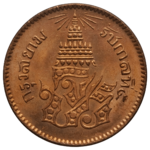 |
 |
Sik ซีก |
1/2 Feuang, 1/16 Baht |
38.5 × 2.5 | 22.57 | Copper | กรุงสยาม (Kingdom of Siam) The Monogram of Rama V รัชกาลที่ ๕ (5th Reign) |
สิ้ก (Sik) ๒ (2) อันเฟื้อง (parts fuang) ๑๒๓๘ (CS 1238) |
1875 |
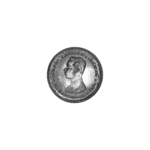 |
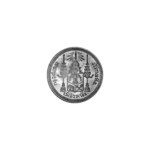 |
Feuang เฟื้อง |
1 Feuang, 1/8 Baht |
16 × 2.3 | 1.89 4~ |
Silver Gold |
สมเด็จพระปรมินทรมหาจุฬาลงกรณ์ (His Majesty King Chulalongkorn) พระจุลจอมเกล้าเจ้าอยู่หัว (King Chulalongkorn) |
กรุงสยาม (Siam) รัชกาลที่๕ (5th Reign) เฟื้องหนึ่ง (1 feuang) |
1875 |
 |
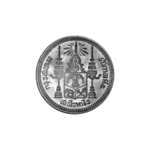 |
Saleung สลึง |
1/16 Tamleung, 1/4 Baht |
21 × 2.3 | 3.82 | Silver | สมเด็จพระปรมินทรมหาจุฬาลงกรณ์ (His Majesty King Chulalongkorn) พระจุลจอมเกล้าเจ้าอยู่หัว (King Chulalongkorn) |
กรุงสยาม (Siam) รัชกาลที่๕ (5th Reign) สลึงหนึ่ง (1 saleung) |
1875 |
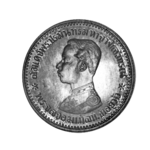 |
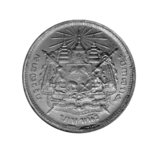 |
Baht บาท |
1/4 Tamleung, 1 Baht |
31 × 2.3 | 15.1 | Silver | สมเด็จพระปรมินทรมหาจุฬาลงกรณ์ (His Majesty King Chulalongkorn) พระจุลจอมเกล้าเจ้าอยู่หัว (King Chulalongkorn) |
กรุงสยาม (Siam) รัชกาลที่๕ (5th Reign) บาทหนึ่ง (1 baht) |
1875 |
Issue 4 - 1888
This is a minor-issue where the lesser denominations' designs are updated, and incorporating the three-parted shield into the design.
Decimalization
The decimalization of the Thai Baht came about at the end of the 19th century. The minister of treasury, Jayanta Mongkol, the Prince Mahisara Rajaharudaya, suggested to King Rama V, that decimalization would make counting easier and further modernize Siam. Initially, there would be one superunit, chang, and subunit, att. with the baht being in the middle. In summary, 64 att = 1 baht = 1/80 chang. In reality, this was just a simplification of the old system, which was scrapped. In which, during the period of 1902–1908, Siam went back to the old system.
Though, in comparison, in Laos, att is used as the subunit, compared to the satang in the Thai Baht.
The second attempt came at the end of Rama V's reign, where it was more widely accepted and put into effective use.
Decimal coinage
In 1897, the first coins denominated in satang were introduced, cupronickel 2+1⁄2, 5, 10 and 20 satang. However, 1 solot, 1 and 2 att coins were struck until 1905 and 1 fuang coins were struck until 1910. In 1908, holed 1, 5 and 10 satang coins were introduced, with the 1 satang in bronze and the 5 and 10 satang in nickel. The 1 and 2 salung were replaced by 25 and 50 satang coins in 1915. In 1937, holed, bronze 1⁄2 satang were issued.
In 1941, a series of silver coins was introduced in denominations of 5, 10 and 20 satang, due to a shortage of nickel caused by World War II. The next year, tin coins were introduced for 1, 5 and 10 satang, followed by 20 satang in 1945 and 25 and 50 satang in 1946. In 1950, aluminium bronze 5, 10, 25 and 50 satang were introduced whilst, in 1957, bronze 5 and 10 satang were issued, along with 1-baht coins struck in an unusual alloy of copper, nickel, silver and zinc. Several Thai coins were issued for many years without changing the date. These include the tin 1942 1 satang and the 1950 5 and 10 satang, struck until 1973, the tin 1946 25 satang struck until 1964, the tin 50 satang struck until 1957, and the aluminium bronze 1957 5, 10, 25 and 50 satang struck until the 1970s. Cupronickel 1-baht coins were introduced in 1962 and struck without date change until 1982.
In 1972, cupronickel 5-baht coins were introduced, switching to cupronickel-clad copper in 1977. Between 1986 and 1988, a new coinage was introduced, consisting of aluminium 1, 5 and 10 satang, aluminium-bronze 25 and 50 satang, cupronickel 1 baht, cupronickel-clad-copper 5 baht and bimetallic 10 baht. Cupronickel-clad-steel 2 baht were introduced in 2005.
Issue 5 - 1897 (Transitional Coinage)
Issue 6 - 1908, 1913, 1929, 1939
Issue 7 - 1937, 1941, 1942, 1945
Issue 8 - 1946
Issue 9 - 1950
Issue 10 - 1972
Issue 11 - 1977
Issue 12 - 1982
| Rama IX, Issue 12 | ||||||||
|---|---|---|---|---|---|---|---|---|
| Image | Value | Dimensions (mm) |
Weight (g) |
Composition | Inscription, Description | Date of Issue | ||
| Obverse | Reverse | Obverse | Reverse | |||||
| 1 baht | 25 × 1.8 | 7 | Cupronickel | ภูมิพลอดุลยเดช (Bhumibol Adunyadej) รัชกาลที่ ๙ (9th Reign) |
ประเทศไทย (Thailand) ๑ บาท (1 baht) พ.ศ.๒๕๒๕ (BE 2525) |
1982 | ||
| 5 baht | 30 × 2.3 | 12 | Cupronickel clad Copper | ภูมิพลอดุลยเดช (Bhumibol Adunyadej) รัชกาลที่ ๙ (9th Reign) |
ประเทศไทย (Thailand) ๕ บาท (5 baht) พ.ศ.๒๕๒๕ (BE 2525) |
1982 | ||
Issue 13 - 1987, 2008, 2009
| Rama IX, Issue 13 | ||||||||
|---|---|---|---|---|---|---|---|---|
| Image | Value | Dimensions (mm) |
Weight (g) |
Composition | Inscription, Description | Date of Issue | ||
| Obverse | Reverse | Obverse | Reverse | |||||
| 25 satang | 16 × 1.35 | 1.9 | Aluminium Bronze | ภูมิพลอดุลยเดช (Bhumibol Adunyadej) รัชกาลที่ ๙ (9th Reign) |
ประเทศไทย (Thailand) ๒๕ สตางค์ 25 (25 satang) พ.ศ.๒๕๔๗ (BE 2547) |
1987 | ||
| Copperplated-Steel | 2008 | |||||||
| 50 satang | 18 × 1.35 | 2.4 | Aluminium Bronze | ภูมิพลอดุลยเดช (Bhumibol Adunyadej) รัชกาลที่ ๙ (9th Reign) |
ประเทศไทย (Thailand) ๕๐ สตางค์ 50 (50 satang) พ.ศ.๒๕๓๘ (BE 2538) |
1987 | ||
| Copperplated-Steel | 2008 | |||||||
| 1 baht | 20 × 1.5 | 3.4 | Cupronickel | ภูมิพลอดุลยเดช (Bhumibol Adunyadej) รัชกาลที่ ๙ (9th Reign) |
ประเทศไทย (Thailand) ๑ บาท (1 baht) พ.ศ.๒๕๔๒ (BE 2542) |
1987 | ||
| 3 | Nickelplated-Steel | 2009 | ||||||
| 2 baht | 21.75 × 1.8 | 4.4 | Nickelplated-Steel | ภูมิพลอดุลยเดช (Bhumibol Adunyadej) รัชกาลที่ ๙ (9th Reign) |
ประเทศไทย (Thailand) ๒ บาท 2 (2 baht) พ.ศ.๒๕๔๙ (BE 2549) |
2005 | ||
| 21.75 × 1.5 | 4 | Aluminium Bronze | ประเทศไทย (Thailand) ๒ บาท 2 (2 baht) พ.ศ.๒๕๕๖ (BE 2556) |
2008 | ||||
| 5 baht | 24 × 2.2 | 7.5 | Cupronickel clad Copper | ภูมิพลอดุลยเดช (Bhumibol Adunyadej) รัชกาลที่ ๙ (9th Reign) |
ประเทศไทย (Thailand) ๕ บาท (5 baht) พ.ศ.๒๕๓๐ (BE 2530) |
1987 | ||
| ประเทศไทย(Thailand) ๕ บาท (5 baht) พ.ศ.๒๕๓๓ (BE 2533) |
1988 | |||||||
| 24 × 1.75 | 6 | 2008 | ||||||
| 10 baht | 26 × 2.15 | 8.5 | Aluminium Bronze (centre) Cupronickel (ring) |
ภูมิพลอดุลยเดช (Bhumibol Adunyadej) รัชกาลที่ ๙ (9th Reign) |
ประเทศไทย(Thailand) ๑๐ บาท 10 (10 baht) พ.ศ.๒๕๔๕ (BE 2545) |
1988 | ||
| 2008 | ||||||||
Current coinage
The current coin series is the 14th issue.
In 2008, in the 13th issue, the Ministry of Finance and the Royal Thai Mint announced the 2009 coin series, which included changes in materials to reduce production costs as well as an update of the image on the obverse to a more recent portrait of the king. The two-baht coin, confusingly similar in color and size to the one-baht coin, was changed from nickel-clad low-carbon steel to aluminium bronze. New two-baht coin was the first of the new series released on February 3, 2009, followed by the satang coins in April, a five-baht coin in May, a ten-baht coin in June, and a one-baht coin in July 2009.
In 2018, the Royal Thai Mint and the Ministry of Finance issued a new series of general circulation coins, featuring the same standard specifications, but feature a portrait of its current king, Maha Vajiralongkorn.
| Coins of the Thai baht (Rama IX) [1] [2] | ||||||||
|---|---|---|---|---|---|---|---|---|
| Value | Technical parameters | Description | Date of first minting | |||||
| Diameter | Mass | Composition | Obverse | Reverse | ||||
| 1 satang 1 | 15 mm | 0.5 g | 97.5% Al, 2.5% Mg | King Bhumibol Adulyadej | Wat Phra That Hariphunchai, Lamphun | 1987 | ||
| 99% Aluminium | 2008 | |||||||
| 5 satang 1 | 16 mm | 0.6 g | 97.5% Al, 2.5% Mg | Wat Phra Pathom Chedi, Nakhon Pathom | 1987 | |||
| 16.5 mm | 99% Aluminium | 2008 | ||||||
| 10 satang 1 | 17.5 mm | 0.8 g | 97.5% Al, 2.5% Mg | Wat Phra That Choeng Chum, Sakon Nakhon | 1987 | |||
| 99% Aluminium | 2008 | |||||||
| 25 satang | 16 mm | 1.9 g | Aluminium bronze | King Bhumibol Adulyadej | Wat Phra Mahathat, Nakhon Si Thammarat | 1987 | ||
| 16 mm | 1.9 g | Copper-plated steel | King Bhumibol Adulyadej | Wat Phra Mahathat, Nakhon Si Thammarat | 2008 | |||
| 50 satang | 18 mm | 2.4 g | Aluminium bronze | King Bhumibol Adulyadej | Wat Phra That Doi Suthep, Chiang Mai | 1987 | ||
| 18 mm | 2.4 g | Copper-plated steel | King Bhumibol Adulyadej | Wat Phra That Doi Suthep, Chiang Mai | 2008 | |||
| 1 baht | 20 mm | 3.4 g | Cupronickel (1986–2008) | King Bhumibol Adulyadej | Wat Phra Kaew, Bangkok | 1986 | ||
| 3 g | Nickel-plated steel (2008–present) | 2008 | ||||||
| 2 baht | 21.75 mm | 4.4 g | Nickel-plated low-carbon steel | King Bhumibol Adulyadej | Wat Saket, Bangkok | 2005 | ||
| 21.75 mm | 4 g | Aluminium bronze | King Bhumibol Adulyadej | Wat Saket, Bangkok | 2008 | |||
| 5 baht | 24 mm | 7.5 g | Copper nickel-clad copper | King Bhumibol Adulyadej | Wat Benchamabophit, Bangkok | 1988 | ||
| 6 g | 2008 | |||||||
| 10 baht | 26 mm | 8.5 g | Outer Ring: Copper-nickel Center Plug: Aluminium bronze |
King Bhumibol Adulyadej | Wat Arun, Bangkok | 1988 | ||
| 2008 | ||||||||
| Coins of the Thai baht (Rama X) | ||||||
|---|---|---|---|---|---|---|
| Image | Value | Composition | Description | Date of minting | ||
| Obverse | Reverse | Obverse | Reverse | |||
| 1 satang | Aluminum | King Maha Vajiralongkorn | Monogram of Maha Vajiralongkorn | 2018 | ||
| 5 satang | Aluminum | King Maha Vajiralongkorn | Monogram of Maha Vajiralongkorn | 2018 | ||
| 10 satang | Aluminum | King Maha Vajiralongkorn | Monogram of Maha Vajiralongkorn | 2018 | ||
| 25 satang | Copper-plated steel | King Maha Vajiralongkorn | Monogram of Maha Vajiralongkorn | 2018 | ||
| 50 satang | Copper-plated steel | King Maha Vajiralongkorn | Monogram of Maha Vajiralongkorn | 2018 | ||
 |
 |
1 baht | Nickel-plated steel | King Maha Vajiralongkorn | Monogram of Maha Vajiralongkorn | 2018 |
 |
 |
2 baht | Aluminum bronze | King Maha Vajiralongkorn | Monogram of Maha Vajiralongkorn | 2018 |
 |
 |
5 baht | Copper nickel-clad copper | King Maha Vajiralongkorn | Monogram of Maha Vajiralongkorn | 2018 |
 |
 |
10 baht | Outer Ring: Copper nickel Center Plug: Aluminium bronze |
King Maha Vajiralongkorn | Monogram of Maha Vajiralongkorn | 2018 |
Remarks
- The 1, 5 and 10 satang are used only internally between banks and are not in circulation.
- Older coins, some of which are still in circulation, had only Thai numerals, but newer designs also have Arabic numerals.
- The standard-issue 10-baht coin has, at the 12 o'clock position on the reverse, raised dots corresponding to Braille cell dot 1 and dots 2-4-5, which correspond to the number 10.
- 10-baht coins are very similar to 2-euro coins in size, shape and weight, and are likewise bi-metallic, although they are worth only 25 eurocents. Vending machines not equipped with up-to-date coin detectors might therefore accept them as €2 coins or old Italian 500 lira coins as well.
- Many commemorative 1-, 2-, 5- and 10-baht coins have been made for special events. There also are 20-, 50-, 100-baht base metal commemorative coins and higher-denomination precious metal coins as well.
In February 2010 the Treasury Department of Thailand stated that it has been planning a new circulation 20-baht coin.
Monarch's profile
Banknotes
In 1851, the government issued notes for 1⁄8, 1⁄4, 3⁄8, 1⁄2 and 1 tical, followed by 3, 4, 6 and 10 tamlueng in 1853. After 1857, notes for 20 and 40 ticals were issued, also bearing their values in Straits dollars and Indian rupees. Undated notes were also issued before 1868 for 5, 7, 8, 12 and 15 tamlueng, and 1 chang. One att notes were issued in 1874.
In 1892, the treasury issued notes for 1, 5, 10, 40, 80, 100, 400 and 800 ticals, called "baht" in the Thai text.
On September 19, 1902, the government introduced notes which were printed by Thomas De La Rue & Company Limited, England, during the reigns of kings Rama V and Rama VI, denominated 5, 10, 20, 100 and 1000 ticals, still called baht in the Thai text — each denomination having many types, with 1 and 50 tical notes following in 1918. In 1925, notes were issued in denominations of 1, 5, 10, 20, 100 and 1,000 baht with the denomination in both Arabic and Thai numerals without English text; English speakers continued to refer to these as "ticals".
On 27 July 2010, the Bank of Thailand announced that the 16th-series banknotes would enter circulation in December 2010. On 9 August 2012, the Bank of Thailand issued a new denomination banknote, 80 baht, to commemorate queen Sirikit's 80th birthday. It was the first Thai banknote that featured Crane's MOTION security thread.
In 2017, the Bank of Thailand announced a new family of banknotes in remembrance of its late king Bhumibol Adulyadej (Rama IX). The notes are the same size and dimensions as the "Series 16" banknotes, with the front designs as before, but the back designs featuring images of the king's life in infancy, adolescence and maturity. The new family of banknotes were issued on September 20.
In 2018, the Bank of Thailand announced a new family of banknotes featuring a portrait of its current king, Maha Vajiralongkorn. The main colors and dimensions of the notes are the same as before, with the back designs featuring images of the Kings of Thailand from past to present. The 20, 50 and 100 baht banknotes were issued on Chakri Memorial Day, April 6, 2018. The final two denominations, 500 and 1,000 baht were issued on the anniversary of the birth of King Maha Vajiralongkorn, July 28, 2018.
Timeline
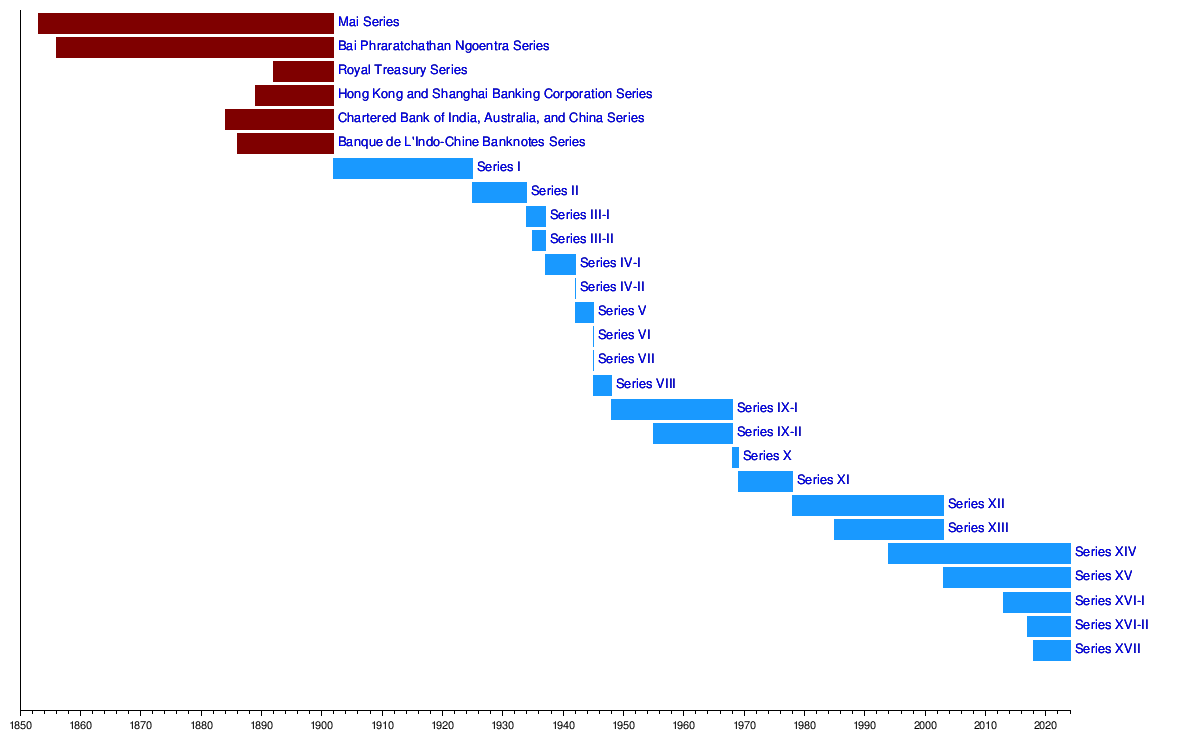
2003-present (Series 14 to Series 17) Later Rama 9 and Rama 10 Era
Images of banknotes have been removed lest they infringe copyright, but may be viewed at the Thai-language article linked in the margin.
Series 14
The 14th series aims to focus on the activities and contributions of the Chakri Kings. There were officially 3 notes issued, but the 50 baht notes were also produced along side. Though this polymer 50 baht is considered to be a part of series 15 even though the production date began in 1994.
| 14th series banknotes | |||||
|---|---|---|---|---|---|
| Value | Dimensions | Main colour | Description | Date of issue | |
| Obverse | Reverse | ||||
| 50 baht
(polymer) |
144 × 72 mm | Blue | King Bhumibol Adulyadej in the uniform of the supreme commander of the armed forces | King Mongkut (Rama IV) | 1994-2004 |
| 100 baht | 150 × 72 mm | Red | King Chulalongkorn (Rama V) and King Mongkut (Rama IV) | 1994-2003 | |
| 500 baht | 156 × 72 mm | Purple | Kings Phra Buddha Yodfa Chulaloke (Rama I) and Phra Buddha Loetla Nabhalai (Rama II) | 1996-2001 | |
| 1,000 baht | 166 × 80 mm | Silver | Kings Bhumibol Adulyadej (Rama IX) and Queen Sirikit | 1992-2005 | |
Series 15
The series 15 aims to update and expand the previous series 14's design. The 1000 baht was resized down. There are two variants of this series, with the second and later variant having updated securities features.
| 15th series banknotes | |||||
|---|---|---|---|---|---|
| Value | Dimensions | Main colour | Description | Date of issue | |
| Obverse | Reverse | ||||
| 20 baht | 138 × 72 mm | Green | King Bhumibol Adulyadej in the uniform of the supreme commander of the armed forces | King Ananda Mahidol (Rama VIII) | 3 March 2003 |
| 50 baht | 144 × 72 mm | Blue | King Mongkut (Rama IV) | 19 March 2004 | |
| 100 baht | 150 × 72 mm | Red | King Chulalongkorn (Rama V) and King Vajiravudh (Rama VI) | 21 October 2005 | |
| 500 baht | 156 × 72 mm | Purple | King Nangklao (Rama III) | 1 August 2001 | |
| 1,000 baht | 162 × 72 mm | Brown | King Bhumibol Adulyadej; Pa Sak Jolasid Dam | 25 November 2005 | |
Series 16
Similar to the series 15, the series 16 banknotes updated the design to include a more later portrait of King Rama 9. There are two variants of this series, the later one being a circulated commemorative series cirrculating for a year after King Rama 9's passing. The Series 16-2 depicts on the reverse, the life and achievements of King Rama 9.
| 16th series banknotes** | |||||
|---|---|---|---|---|---|
| Value | Dimensions | Main colour | Description | Date of issue | |
| Obverse | Reverse | ||||
| 20 baht | 138 × 72 mm | Green | King Bhumibol Adulyadej in the Royal House of Chakri gown | King Ram Khamhaeng the Great on the Manangkhasila Asana Throne monument; invention of the Thai script; Ramkhamhaeng stele | 1 April 2013 |
| 50 baht | 144 × 72 mm | Blue | King Naresuan the Great pouring water for declaration of independence monument; Statue of king Naresuan the Great on war elephant; Phra Chedi Chai Mongkol temple | 18 January 2012 | |
| 100 baht | 150 × 72 mm | Red | King Taksin the Great monument in Wongwian Yai circle; Phra Ratchawang Doem (King Taksin's palace); Wichai Prasit Fortress Thonburi | 26 February 2015 | |
| 500 baht | 156 × 72 mm | Violet | King Buddha Yodfa Chulalok the Great (King Rama I) monument; Wat Phra Chetuphon Vimolmangklararm Rajwaramahaviharn (Wat Pho); Phra Sumen Fort (Bangkok city wall) | 12 May 2014 | |
| 1,000 baht | 162 × 72 mm | Brown | King Chunla Chom Klao the Great (King Rama V) monument; Ananta Samakhom throne hall, Dusit palace ground king's monument, end of slavery in Siam | 21 August 2015 | |
Series 17
| 17th series banknotes | |||||
|---|---|---|---|---|---|
| Value | Dimensions | Main colour | Description | Date of issue | |
| Obverse | Reverse | ||||
| 20 baht | 138 × 72 mm | Green | King Maha Vajiralongkorn in the uniform of the commander of the Royal Thai Air Force and wearing Order of the Nine Gems | Kings Phra Buddha Yodfa Chulaloke (Rama I) and Phra Buddha Loetla Nabhalai (Rama II) | 6 April 2018 |
| 50 baht | 144 × 72 mm | Blue | Kings Nangklao (Rama III) and Mongkut (Rama IV) | 6 April 2018 | |
| 100 baht | 150 × 72 mm | Red | Kings Chulalongkorn (Rama V) and Vajiravudh (Rama VI) | 6 April 2018 | |
| 500 baht | 156 × 72 mm | Purple | Kings Prajadhipok (Rama VII) and Ananda Mahidol (Rama VIII) | 28 July 2018 | |
| 1,000 baht | 162 × 72 mm | Brown | Kings Bhumibol Adulyadej (Rama IX) and Maha Vajiralongkorn (Rama X) | 28 July 2018 | |
1948-2003 (Series 9 to Series 13) Early Rama 9 Era
These banknotes series are not demonitized, hence would be legal tender. Though, they are never seen in circulation anymore.
These banknotes images are allowed under a strict copyright infringement exemption under the Chapter 1: Copyright, Part 6: Exceptions to Infringement of Copyright, Clause 7 of Copyright Act B.E. 2537 (1994) Amended by Copyright Act (NO. 2) B.E. 2558 (2015), and Copyright Act (NO.3) B.E. 2558 (2015) and Copyright Act (NO.4) B.E. 2561 (2018): reproduction, adaptation in part of a work or abridgement or making a summary by a teacher or an educational institution so as to distribute or sell to students in a class or in an educational institution, provided that the act is not for profit;[3]
So as to serve as an educational material, only one side is shown, and any series beyond series 13 is omitted.
Series 9
Series 9 banknotes are produced by Thomas De La Rue & Company Limited. There are two variations within this series, the young, and new portrait. According to the Bank of Thailand, the color schemes of this series established the denominations' colors for all of the following series due to the series circulating for 20 years.
| 9th series banknotes (First Portrait; Second Portrait) | |||||||
|---|---|---|---|---|---|---|---|
| Value | Dimensions | Main colour | Description | Date of issue | |||
| Obverse | Reverse | ||||||
| 50 satang | 115 × 63 mm | Green | The Constitution of Siam | Phra Samut Chedi | 1948-1969 | ||
| 1 baht | 126 × 66 mm | Green | King Bhumibol Adulyadej in the uniform of the supreme commander of the armed forces, and Wat Pho | Anandasamakom Throne Hall | 1948-1955;
1955-1969 |
||
| 5 baht | 136 × 77 mm | Green and Grey | King Bhumibol Adulyadej in the uniform of the supreme commander of the armed forces, and Phra Pathomma Chedi | Anandasamakom Throne Hall | 1948-1955;
1955-1969 |
||
| 10 baht | 146 × 86 mm | Brown | King Bhumibol Adulyadej in the uniform of the supreme commander of the armed forces, and Pharakarn Fortress | Anandasamakom Throne Hall | 1948-1953;
1953-1969 |
||
| 20 baht | 146 × 86 mm | Green | King Bhumibol Adulyadej in the uniform of the supreme commander of the armed forces, and Grand Palace | Anandasamakom Throne Hall | 1948-1955;
1955-1971 |
||
| 100 baht | 145 × 86 mm | Red | King Bhumibol Adulyadej in the uniform of the supreme commander of the armed forces, and Wat Arun | Anandasamakom Throne Hall | 1948-1955;
1955-1968 |
||
Series 10
Series 10 banknotes are produced by Thomas De La Rue & Company Limited, due to heavy counterfeiting, series 10 was issued in series 9's stead. The 100 baht is the only denomination issued in this series.
| 10th series banknotes | |||||||
|---|---|---|---|---|---|---|---|
| Value | Dimensions | Main colour | Description | Date of issue | |||
| Obverse | Reverse | ||||||
| 100 baht | 145 × 86 mm | Red | King Bhumibol Adulyadej in uniform | Royal barge "Suphannahong" | 1968-1969 | ||
Series 11
In this series, the 500 baht note was introduced for the first time ever, this coincides with the Bank of Thailand fully converting to an in-house production. As a consequence, the 1 baht note's production was cancelled.
| 11th series banknotes | |||||||
|---|---|---|---|---|---|---|---|
| Value | Dimensions | Main colour | Description | Date of issue | |||
| Obverse | Reverse | ||||||
| 5 baht | 130 × 67.5 mm | Violet | King Bhumibol Adulyadej in full regalia | The Arphonphimoke Prasat Pavilion | 1969-1978 | ||
| 10 baht | 135 × 70 mm | Brown | King Bhumibol Adulyadej in full regalia | Wat Benchamabophit | 1969-1978 | ||
| 20 baht | 140 × 72 mm | Green | King Bhumibol Adulyadej in full regalia | Royal barge "Anantanakkharat" | 1971-1978 | ||
| 100 baht | 150 × 77 mm | Red | King Bhumibol Adulyadej in full regalia | Wat Phra Si Rattana Satsadaram | 1969-1978 | ||
| 500 baht | 160 × 80 mm | Purple | King Bhumibol Adulyadej in full regalia | Phra Prang Sam Yod | 1975-1988 | ||
Series 12 & 13
Series 12 and 13 aims to glorify past thai monarchs, the Bank of Thailand dubbed this as "The Great Series". The 5 baht note's production was cancelled. The note 50 baht and 500 baht are a part of series 13, and was issued to commemorate the bicentennial celebration of Bangkok in 1982, though the production had to be delayed for the new printing press to be installed.
| 12th series banknotes and 13th series banknotes | |||||||
|---|---|---|---|---|---|---|---|
| Value | Dimensions | Main colour | Description | Date of issue | |||
| Obverse | Reverse | ||||||
| 10 baht | 132 × 69 mm | Brown | King Bhumibol Adulyadej in uniform | Equestrian statue of King Chulalongkorn | 1978-2003 | ||
| 20 baht | 139 × 72 mm | Green | King Bhumibol Adulyadej in uniform | King Taksin's Statue at Chantaburi | 1978-2003 | ||
| 50 baht | 144 × 72 mm | Blue | King Bhumibol Adulyadej in full regalia | Anandasamakom Throne Hall, the Coronation of King Rama VII Prajadhipok | 1985-1996 | ||
| 50 baht (polymer) | 144 × 72 mm | Blue and Yellow | King Bhumibol Adulyadej in full regalia | Anandasamakom Throne Hall, the Coronation of King Rama VII Prajadhipok | 1996-1997 | ||
| 100 baht | 154 × 80 mm | Red | King Bhumibol Adulyadej in uniform | King Naresuan the Great atop War Elephant | 1978-1994 | ||
| 500 baht | 160 × 80 mm | Purple | King Bhumibol Adulyadej in the uniform of the supreme commander of the armed forces | The Monument of King Rama I | 1988-1996 | ||
1935-1948 (Series 3 Type II to Series 8) Rama 8 Era
Series 3 Type II
Series 3 type ii banknotes are produced by Thomas De La Rue & Company Limited. It is the first series to hold Rama 8's portrait, which replaced Rama 7's portrait in the Type I.
| type II 3th series banknotes | |||||||
|---|---|---|---|---|---|---|---|
| Value | Dimensions | Main colour | Description | Date of issue | |||
| Obverse | Reverse | ||||||
| 1 baht | 135 × 75 mm | Green | Young King Ananda and Suphannahongse Royal Barge | Phra Samut Chedi Temple | 1935-1937 | ||
| 5 baht | 155 × 85 mm | Green and Grey | Young King Ananda and Temple of the Emerald Buddha | Phra Samut Chedi Temple | 1935-1937 | ||
| 10 baht | 175 × 95 mm | Brown | Young King Ananda and a Scene of the Mae Ping River | Phra Samut Chedi Temple | 1935-1937 | ||
| 20 baht | 175 × 95 mm | Green | Young King Ananda and a Scene of a Riverside Community | Phra Samut Chedi Temple | 1935-1937 | ||
Series 4 Type I
Series 4 type i banknotes are produced by Thomas De La Rue & Company Limited.
| type I 4th series banknotes | |||||||
|---|---|---|---|---|---|---|---|
| Value | Dimensions | Main colour | Description | Date of issue | |||
| Obverse | Reverse | ||||||
| 1 baht | 125 × 65 mm | Green | Young King Ananda and Phra Samut Chedi | Anandasamakom Throne Hall | 1937-1942 | ||
| 5 baht | 135 × 76 mm | Green and Grey | Young King Ananda and Phra Pathom Chedi | Anandasamakom Throne Hall | 1937-1942 | ||
| 10 baht | 145 × 87 mm | Brown | Young King Ananda and Mahakarn Fortress | Anandasamakom Throne Hall | 1937-1942 | ||
| 20 baht | 145 × 87 mm | Green | Young King Ananda and Golden Mountain Stupa | Anandasamakom Throne Hall | 1937-1942 | ||
| 1000 baht | 195 × 100 mm | Red | Young King Ananda and a Dusidabhirom Pavilion | Anandasamakom Throne Hall | 1937-1942 | ||
Series 4 Type II
Series 4 type ii banknotes are produced by Royal Thai Survey Department and the Naval Hydrographic Department. During world war 2, Thailand allied with the Empire of Japan. This meant that the government of Thailand could not order banknotes from Thomas De La Rue & Company Limited.
| type I 4th series banknotes | |||||||
|---|---|---|---|---|---|---|---|
| Value | Dimensions | Main colour | Description | Date of issue | |||
| Obverse | Reverse | ||||||
| 1 baht | 125 × 65 mm | Green | Young King Ananda and Phra Samut Chedi | Anandasamakom Throne Hall | 1942 | ||
| 10 baht | 146 × 86 mm | Brown | Young King Ananda and Mahakarn Fortress | Anandasamakom Throne Hall | 1942 | ||
| 20 baht | 146 × 86 mm | Green | Young King Ananda and Grand Palace | Anandasamakom Throne Hall | 1942 | ||
| 100 baht | 125 × 65 mm | Cyan | Young King Ananda and a Wat Arun | Anandasamakom Throne Hall | 1942 | ||
Series 5
Series 5 banknotes are produced by Notes Printing Works of Japan.
| 5th series banknotes | |||||||
|---|---|---|---|---|---|---|---|
| Value | Dimensions | Main colour | Description | Date of issue | |||
| Obverse | Reverse | ||||||
| 50 satang | 117 × 63 mm | Green | Young King Ananda | Grand Palace | 1942-1945 | ||
| 1 baht | 125 × 65 mm | Grey | Young King Ananda and Pumin Temple | Grand Palace | 1942-1945 | ||
| 5 baht | 135 × 75 mm | Green | Young King Ananda and Wat Benchamabophit Dusitwanaram | Grand Palace | 1942-1945 | ||
| 10 baht | 145 × 85 mm | Green | Young King Ananda and Wat Pho | Grand Palace | 1942-1945 | ||
| 20 baht | 155 × 90 mm | Green | Young King Ananda and Aisawan Tipaya-ast Pavilion | Grand Palace | 1942-1945 | ||
| 100 baht | 175 × 100 mm | Red | Young King Ananda and Wat Arun | Grand Palace | 1942-1945 | ||
| 1000 baht | 175 × 100 mm | Green | Young King Ananda and Grand Palace | Grand Palace | 1942-1945 | ||
Series 6
Series 6 banknotes are produced by Royal Thai Survey Department.
| 6th series banknotes | |||||||
|---|---|---|---|---|---|---|---|
| Value | Dimensions | Main colour | Description | Date of issue | |||
| Obverse | Reverse | ||||||
| 20 baht | 147 × 87 mm | Green | Young King Ananda and Dusidapirom Pavilion | Anandasamakom Throne Hall | 1945 | ||
| 100 baht | 147 × 87 mm | Green | Young King Ananda and Wat Arun | Anandasamakom Throne Hall | 1945 | ||
Series 7
Series 7 banknotes relied on private printing under the supervision of the Bank of Thailand. According to the Bank of Thailand, the quality of this series was barely satisfactory.
| 7th series banknotes | |||||||
|---|---|---|---|---|---|---|---|
| Value | Dimensions | Main colour | Description | Date of issue | |||
| Obverse | Reverse | ||||||
| 1 baht | 104 × 54 mm | Cyan | King Ananda and Phra Samut Chedi | Anandasamakom Throne Hall | 1945 | ||
| 5 baht | 135 × 76 mm | Purple | King Ananda and Phra Patom Chedi | Anandasamakom Throne Hall | 1945 | ||
| 10 baht | 135 × 76 mm | Green | King Ananda and Mahakarn Fortress | Anandasamakom Throne Hall | 1945 | ||
| 50 baht | 104 × 54 mm | Red | King Ananda and Wat Benchamabophit Dusitwanaram | Anandasamakom Throne Hall | 1945 | ||
Special Series Banknote
The special series are banknotes which were issued during world war 2, each at different times.
| special series banknotes | |||||||
|---|---|---|---|---|---|---|---|
| Value | Dimensions | Main colour | Description | Date of issue | |||
| Obverse | Reverse | ||||||
| 50 satang (overprint) | 145 × 85 mm | Grey | Young King Ananda and Wat Pho | Grand Palace | 1946 | ||
| 50 satang (Kong Tek Note) | 125 × 65 mm | Grey and Yellow | none | Anandasamakom Throne Hall | 1946 | ||
| 1 baht (Kong Tek Note) | 117 × 63 mm | Grey and Red | King Ananda and a 16 pointed Star symbol | Anandasamakom Throne Hall | 1942 | ||
| 1 baht (Invasion Note) | 114 × 73 mm | Grey | none | none | 1946 | ||
| 1000 baht | 104 × 54 mm | Red | King Ananda and Phra Prang Sam Yod | Anandasamakom Throne Hall | 1943 | ||
Series 8
At the end of world war 2, Thomas De La Rue & Company Limited's printing house suffered damage from German bombing, thus the Royal Thai Government turned to the United States government to produce the series 8. The Tudor Press company produced this series.
| 8th series banknotes | |||||||
|---|---|---|---|---|---|---|---|
| Value | Dimensions | Main colour | Description | Date of issue | |||
| Obverse | Reverse | ||||||
| 1 baht | 110 × 66 mm | Green | King Ananda and Phra Patom Chedi | The Constitution of Siam | 1945-1948 | ||
| 5 baht | 110 × 66 mm | Blue | King Ananda and Phra Patom Chedi | The Constitution of Siam | 1945-1948 | ||
| 10 baht | 110 × 66 mm | Brown | King Ananda and Phra Patom Chedi | The Constitution of Siam | 1945-1948 | ||
| 20 baht | 156 × 90 mm | Violet | King Ananda and Phra Patom Chedi | The Constitution of Siam | 1945-1948 | ||
| 100 baht | 156 × 90 mm | Brown and Cyan | King Ananda and Phra Patom Chedi | The Constitution of Siam | 1945-1948 | ||
1925-1935 (Series 2 to Series 3 Type I) Rama 7 Era
Series 2
Series 2 banknotes are produced by Thomas De La Rue & Company Limited.
| 2th series banknotes | |||||||
|---|---|---|---|---|---|---|---|
| Value | Dimensions | Main colour | Description | Date of issue | |||
| Obverse | Reverse | ||||||
| 1 baht | 135 × 75 mm | Blue and Yellow | none | Royal Ploughing Ceremony | 1925-1934 | ||
| 5 baht | 155 × 85 mm | Green and Grey | none | Royal Ploughing Ceremony | 1925-1934 | ||
| 10 baht | 175 × 95 mm | Red | none | Royal Ploughing Ceremony | 1925-1934 | ||
| 20 baht | 175 × 95 mm | Green | none | Royal Ploughing Ceremony | 1925-1934 | ||
| 100 baht | 175 × 95 mm | Blue and Green | none | Royal Ploughing Ceremony | 1928-1934 | ||
| 1000 baht | 195 × 105 mm | Red | none | Royal Ploughing Ceremony | 1928-1934 | ||
Series 3 Type I
Series 3 type i banknotes are produced by Thomas De La Rue & Company Limited. This series was actually delayed due to the Siamese Revolution to abolish the absolute monarch and transform the institution into a constitutional monarchy. The issuance was supposed to happen in the early 1930s.
| type I 3th series banknotes | |||||||
|---|---|---|---|---|---|---|---|
| Value | Dimensions | Main colour | Description | Date of issue | |||
| Obverse | Reverse | ||||||
| 1 baht | 135 × 75 mm | Green | King Prajadipok and Suphannahongse Royal Barge | Phra Samut Chedi Temple | 1934-1935 | ||
| 5 baht | 155 × 85 mm | Green and Grey | King Prajadipok and Temple of the Emerald Buddha | Phra Samut Chedi Temple | 1934-1935 | ||
| 10 baht | 175 × 95 mm | Brown | King Prajadipok and a Scene of the Mae Ping River | Phra Samut Chedi Temple | 1934-1935 | ||
| 20 baht | 175 × 95 mm | Green | King Prajadipok and a Scene of a Riverside Community | Phra Samut Chedi Temple | 1934-1935 | ||
1902-1925 (Series 1) Rama 5 and Rama 6 Era
Series 1
Series 1 was chosen due to the series which precedes this were non-decimal. Series 1 banknotes is the first series to be produced by Thomas De La Rue & Company Limited. In 1900, Charles James Rivett Carnac, a Royal Treasury Ministry advisor proposed that the Siamese Baht followed the issuances of banknotes followed the British standard. The banknote department was established quickly thereafter. The main characteristic of this series was that the notes are onesided and multilingual, containing Chinese, Malay (in Jawi script), and Latin script. It was also the last series to use the term "tical" to refer to the Thai Baht, and the largest in term of size of circulated notes.
| 1th series banknotes | |||||||
|---|---|---|---|---|---|---|---|
| Value | Dimensions | Main colour | Description | Date of issue | |||
| Obverse | Reverse | ||||||
| 1 tical | 165 × 105 mm | Cyan | none | blank | 1918-1925 | ||
| 5 ticals | 165 × 105 mm | Grey | none | blank | 1902-1925 | ||
| 10 ticals | 205 × 126 mm | Brown | none | blank | 1902-1925 | ||
| 20 ticals | 205 × 126 mm | Green | none | blank | 1902-1925 | ||
| 50 ticals | 165 × 105 mm | Grey | none | blank | 1918-1925 | ||
| 100 ticals | 205 × 126 mm | Grey | none | blank | 1903-1928 | ||
| 1000 ticals | 205 × 126 mm | Red | none | blank | 1902-1928 | ||
Before 1902 Pre Decimalization Era
The characteristic of the banknotes of this era is that there were no series issued at the same time, rather they are issued sporadically and have multiple banks producing their own banknotes.
1851-1868 Rama 4 Era Banknotes
1868-1902 Rama 5 Era Banknotes
Royal Tresury Banknotes
| Image | Value | Date of Issue |
|---|---|---|
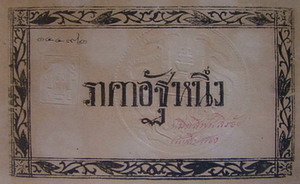 |
1 Att | 1874 |
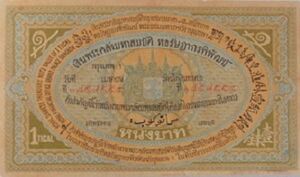 |
1 Tical | 1892 |
 |
5 Tical | |
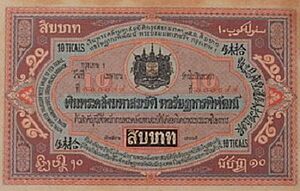 |
10 Tical | |
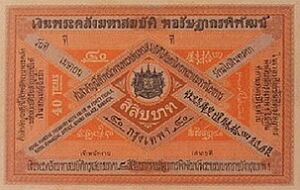 |
40 Tical | |
 |
80 Tical | |
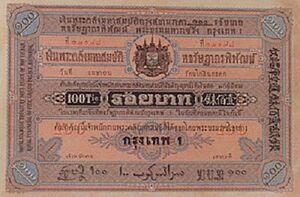 |
100 Tical | |
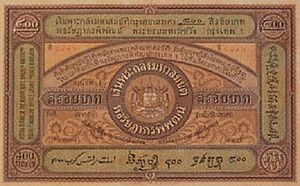 |
400 Tical | |
 |
800 Tical |
The Hongkong and Shanghai Banking Corporation Limited (HSBC) Banknotes
| Image | Value | Date of Issue |
|---|---|---|
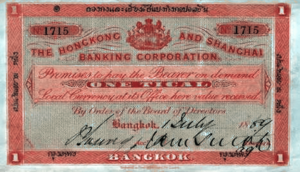 |
1 Tical | 1889 |
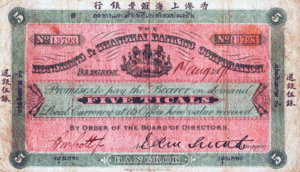 |
5 Tical | |
 |
10 Tical | |
 |
40 Tical | |
 |
80 Tical | |
 |
100 Tical | |
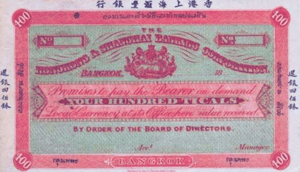 |
400 Tical |
The Chartered Bank of India Australia & China Banknotes
| Image | Value | Date of Issue |
|---|---|---|
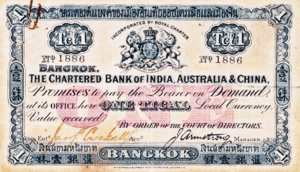 |
5 Tical | 1984 |
 |
10 Tical | |
 |
40 Tical | |
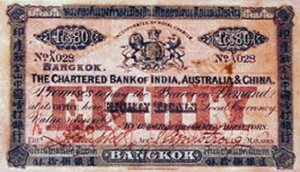 |
80 Tical | |
 |
100 Tical | |
 |
400 Tical |
Banque de L'Indo-Chine Banknotes
| Image | Value | Date of Issue |
|---|---|---|
 |
5 Tical | 1986 |
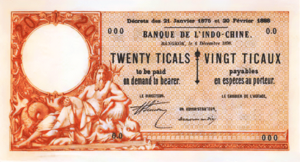 |
20 Tical | |
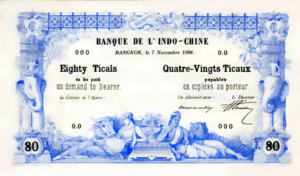 |
80 Tical | |
 |
100 Tical |
Money and unit of mass
Ngoen (เงิน) is Thai for "silver" as well as the general term for money, reflecting the fact that the baht (or tical) is foremost a unit of weight for precious metals and gemstones. One baht = 15.244 grams. Since the standard purity of Thai gold is 96.5 percent, the actual gold content of one baht by weight is 15.244 × 0.965 = 14.71046 grams; equivalent to about 0.473 troy ounces. 15.244 grams is used for bullion; in the case of jewellery, one baht should be more than 15.16 grams.
Historical Coinage Material
| Example Coin | Material | Date in Use | Denomation Minted |
|---|---|---|---|
| Gold | 1863-1905*
*the coins mintage date were only in 1863 & 1876, but they were demonitized by the decimalization. |
Pre-Decimal Coinage
|
|
| Silver | 1860-1962 | Pre-Decimal Coinage
Decimal Coinage
|
|
| Tin | 1860-1950 | Pre-Decimal Coinage
Decimal Coinage
|
|
| Copper | 1865 - 1905 | Pre-Decimal Coinage
|
|
| Brass | 1865-1977 | Pre-Decimal Coinage
Decimal Coinage
|
|
| Bronze | 1887-1957 | Pre-Decimal Coinage
Decimal Coinage
|
|
| Nickel | 1908-1937 | Decimal Coinage
|
|
| Aluminium-Bronze | 1950-present | Decimal Coinage
|
|
| Cupronickel | 1897-present | Transitional Coinage (1897-1905)
Decimal Coinage
|
|
| Nickel-Plated Steel | 2005-present | Decimal Coinage
|
|
| *inner part | Copper-Aluminium-Nickel | 2008-present | Decimal Coinage
|
| *no wiki-image exist a Al-Br coin version is used | Copper-Plated Steel | 2008-present | Decimal Coinage
|
| this table only includes milled coins, podduangs, knife-cash, and etc. are not included | |||
Exchange rates
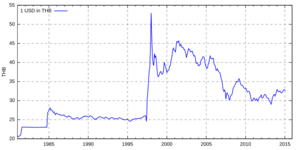
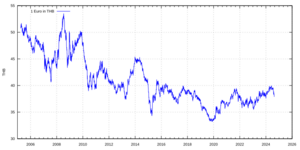
The Bank of Thailand adopted a series of exchange controls on 19 December 2006, which resulted in a significant divergence between offshore and onshore exchange rates, with spreads of up to 10 percent between the two markets. Controls were broadly lifted on 3 March 2008 and there is now no significant difference between offshore and onshore exchange rates.
| 2000 | 2001 | 2002 | 2003 | 2004 | 2005 | 2006 | 2007 | 2008 | 2009 |
| 40.24 | 40.26 | 37.92 | 32.34 | 32.99 | 34.34 | 31.73 | 30.48 | 31.07 | 30.71 |
| 2010 | 2011 | 2012 | 2013 | 2014 | 2015 | 2016 | 2017 | 2018 | 2019 |
| 32.48 | 34.25 | 35.28 | 33.91 | 32.48 | 34.25 | 35.30 | 33.94 | 32.31 | 31.05 |
| 2020 | 2021 | 2022 | 2023 | 2024 | 2025 | 2026 | 2027 | 2028 | 2029 |
| 31.30 |
(Source 1999–2013: usd.fx-exchange.com)
(Source 2014–2020: Bank of Thailand) [4]
| Current THB exchange rates | |
|---|---|
| From Google Finance: | AUD CAD CHF EUR GBP HKD JPY USD INR TWD |
| From Yahoo! Finance: | AUD CAD CHF EUR GBP HKD JPY USD INR TWD |
| From XE.com: | AUD CAD CHF EUR GBP HKD JPY USD INR TWD |
| From OANDA: | AUD CAD CHF EUR GBP HKD JPY USD INR TWD |
| From fxtop.com: | AUD CAD CHF EUR GBP HKD JPY USD INR TWD |
See also
- Economy of Thailand
- Stock Exchange of Thailand


